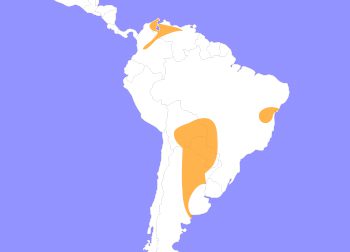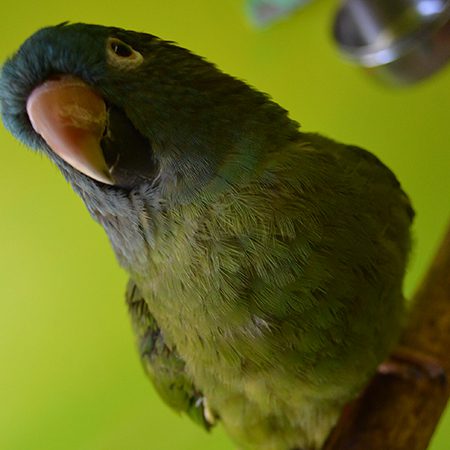Blue Crowned Conure
Thectocercus acuticaudatus
The blue-crowned conure is a small green Neotropical parrot with a blue head and pale beak native to large parts of South America, from eastern Colombia in the north to northern Argentina in the south. Its natural habitat includes savannas, woodlands, and rainforests.The blue-crowned conure is a medium-sized bird measuring approximately 37 cm (14.5 in) in length and weighing between 140 and 190 g (4.9 and 6.7 oz).
Blue-crowns are born with red coloring around the head, but blue-crowns are predominantly green, with dull blue coloring on the forehead, crown, cheeks, and ears in the nominate, but less blue in other subspecies. It has a ring of white featherless skin around each eye, though this is bright orange-yellow in wild. The breast feathers may also be tinged with blue, though they are more commonly green to yellow-green.
Blue-crowned parakeets are generally called blue-crowned conures in aviculture. They are social birds and are relatively good talkers compared to other conures.[5] They have become quite popular as pets, with a reputation as one of the "easier" parrots to care for. However, they are also intelligent, high-energy birds that require a lot of attention and a cage with ample room and toys. They can also be quite loud at times. Consequently, they are more appropriate companions for serious bird enthusiasts rather than the casual birdkeeper.

Blue Crowned Conures are native to South America, ranging from Colombia to Northern Argentina.
HABITAT -Its natural habitat includes savannas, woodlands, and rainforests.
DIET -In the wild they feast on fresh fruits, vegetables, nuts, berries, and grains.
FUN FACT -They are extremely sociable and may live in flocks of up to 100 individuals.
SOCIAL BEHAVIOR -They are very affectionate social creatures, bonding strongly with their owners.
ACTIVITY -They are diurnal being most active during the day and resting during the evening.
PREDATORS -Predators include birds of prey such as hawks, falcons, and owls, rats and snakes.
SIZE -Measuring 14.5 in in length and weighing between 4.9 and 6.7 oz.
RELATIVES -There are 5 subspecies of the blue crowned conure.
CONSERVATION -Blue Crowned Conures are categorized as LC (Least Concern) species by the IUCN.
Cub Creek Animal Care Information
Housing - Einstein is currently housed in the Cat Room in a spacious cage that is bedded with pine shavings for easier clean up. This cage has many branches stretched across that they can walk around on, as well as the cage bars themselves. There is also a nest box attached to the side that he can enter and relax in.
Diet - Our conures are fed ZuPreem FruitBlend medium bird pellets that give them all the vitamins and nutrients they need to be healthy. They also get fresh bird salad daily, which includes apple, shredded sweet potato, and greens. They are also given access to fresh water daily.
Enrichment - Living with another conure, Sunday, provides enrichment through daily interactions. Campers can use cardboard, twine, and pretty much anything we can find to make hanging toys that can have food hidden in them or just used to swing on!

